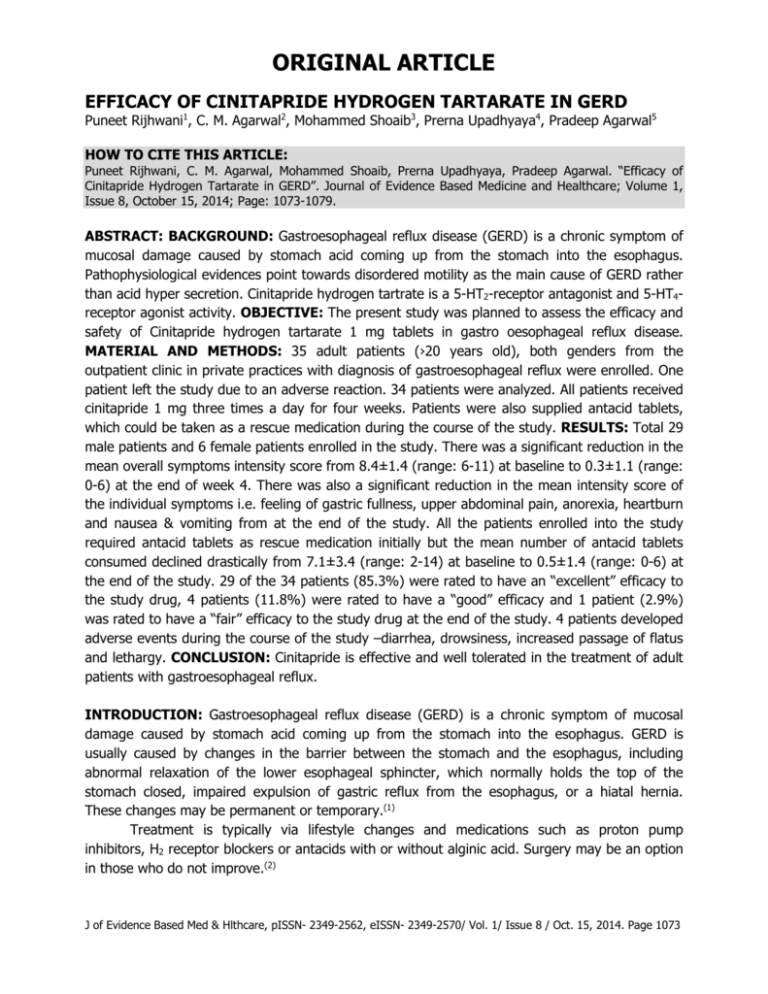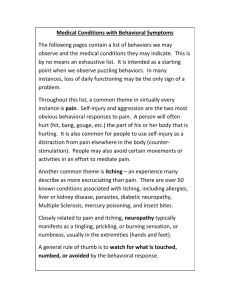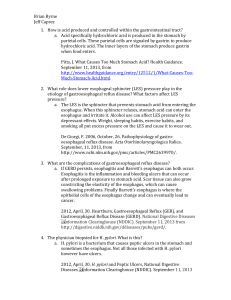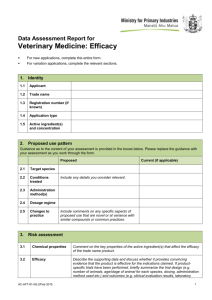efficacy of cinitapride hydrogen tartarate in gerd
advertisement

ORIGINAL ARTICLE EFFICACY OF CINITAPRIDE HYDROGEN TARTARATE IN GERD Puneet Rijhwani1, C. M. Agarwal2, Mohammed Shoaib3, Prerna Upadhyaya4, Pradeep Agarwal5 HOW TO CITE THIS ARTICLE: Puneet Rijhwani, C. M. Agarwal, Mohammed Shoaib, Prerna Upadhyaya, Pradeep Agarwal. “Efficacy of Cinitapride Hydrogen Tartarate in GERD”. Journal of Evidence Based Medicine and Healthcare; Volume 1, Issue 8, October 15, 2014; Page: 1073-1079. ABSTRACT: BACKGROUND: Gastroesophageal reflux disease (GERD) is a chronic symptom of mucosal damage caused by stomach acid coming up from the stomach into the esophagus. Pathophysiological evidences point towards disordered motility as the main cause of GERD rather than acid hyper secretion. Cinitapride hydrogen tartrate is a 5-HT2-receptor antagonist and 5-HT4receptor agonist activity. OBJECTIVE: The present study was planned to assess the efficacy and safety of Cinitapride hydrogen tartarate 1 mg tablets in gastro oesophageal reflux disease. MATERIAL AND METHODS: 35 adult patients (›20 years old), both genders from the outpatient clinic in private practices with diagnosis of gastroesophageal reflux were enrolled. One patient left the study due to an adverse reaction. 34 patients were analyzed. All patients received cinitapride 1 mg three times a day for four weeks. Patients were also supplied antacid tablets, which could be taken as a rescue medication during the course of the study. RESULTS: Total 29 male patients and 6 female patients enrolled in the study. There was a significant reduction in the mean overall symptoms intensity score from 8.4±1.4 (range: 6-11) at baseline to 0.3±1.1 (range: 0-6) at the end of week 4. There was also a significant reduction in the mean intensity score of the individual symptoms i.e. feeling of gastric fullness, upper abdominal pain, anorexia, heartburn and nausea & vomiting from at the end of the study. All the patients enrolled into the study required antacid tablets as rescue medication initially but the mean number of antacid tablets consumed declined drastically from 7.1±3.4 (range: 2-14) at baseline to 0.5±1.4 (range: 0-6) at the end of the study. 29 of the 34 patients (85.3%) were rated to have an “excellent” efficacy to the study drug, 4 patients (11.8%) were rated to have a “good” efficacy and 1 patient (2.9%) was rated to have a “fair” efficacy to the study drug at the end of the study. 4 patients developed adverse events during the course of the study –diarrhea, drowsiness, increased passage of flatus and lethargy. CONCLUSION: Cinitapride is effective and well tolerated in the treatment of adult patients with gastroesophageal reflux. INTRODUCTION: Gastroesophageal reflux disease (GERD) is a chronic symptom of mucosal damage caused by stomach acid coming up from the stomach into the esophagus. GERD is usually caused by changes in the barrier between the stomach and the esophagus, including abnormal relaxation of the lower esophageal sphincter, which normally holds the top of the stomach closed, impaired expulsion of gastric reflux from the esophagus, or a hiatal hernia. These changes may be permanent or temporary.(1) Treatment is typically via lifestyle changes and medications such as proton pump inhibitors, H2 receptor blockers or antacids with or without alginic acid. Surgery may be an option in those who do not improve.(2) J of Evidence Based Med & Hlthcare, pISSN- 2349-2562, eISSN- 2349-2570/ Vol. 1/ Issue 8 / Oct. 15, 2014. Page 1073 ORIGINAL ARTICLE Pathophysiological evidences point towards disordered motility as the main cause of GERD rather than acid hypersecretion. The key feature is disordered function of lower oesophageal sphincter. Principal symptoms of GERD are delayed gastric emptying and decreased peristalsis in oesophagus. The use of prokinetic agents thus seems to be logical. Due to superior efficacy over other drugs, prokinetic agents are the drug of choice for acute management and maintenance therapy of GERD.(3) Cinitapride hydrogen tartrate is a substituted benzamide with 5-HT2-receptor antagonist and 5-HT4-receptor agonist activity, which has been used for the treatment of gastrointestinal disorders, associated with motility disturbances such as gastroesophageal reflux disease, nonulcer dyspepsia and delayed gastric emptying.(4) The present study was planned to assess the efficacy and safety of Cinitapride hydrogen tartarate 1 mg tablets in gastro oesophageal reflux disease. MATERIAL AND METHODS: It is an open label study in patients with gastroesophageal reflux disease. A total of 35 patients were enrolled in our centre in this open label study. 34 of these 35 patients enrolled into the study in our centre completed the study as per the Protocol while the remaining 1 patient discontinued taking the study drug after Week 1 due to adverse event. At the end of the study, 34 patients were analysed for efficacy and all the 35 patients were analysed for tolerability. Patients were instructed to take one tablet of Cinitapride hydrogen tartrate 1 mg thrice a day before meals for the entire duration of the study i.e. 4 weeks The schedule of visits for the patients was as follows: Visit 1 Visit 2 Visit 3 Visit 4 Week 0 Week 1 Week 2 Week 3 Visit 5 Week 4 Patients were also supplied antacid tablets, which could be taken as a rescue medication during the course of the study. The consumption of these antacid tablets was also recorded in the CRF on a weekly basis. RESULTS: Demographic Data: The patients enrolled into this study in our centre comprised of 29 male patients (82.9%) and 6 female patients (17.1%). The mean age of the patients enrolled into this study was 38.2±14.6 years with a range of 20-80 years. The mean body weight and height of the patients enrolled into the study was 58.6±10.3 kg (range: 40-86 kg) and 162.6±6.7 cm (range: 150-175 cm) respectively. Efficacy Data: The primary efficacy variable was the change in the mean intensity score of the symptoms (overall and individual) at the end of the study (week 4) as compared to the baseline (prior to initiation of the therapy i.e. week 0). There was a significant reduction in the mean overall symptoms intensity score from 8.4±1.4 (range: 6-11) at baseline to 0.3±1.1 (range: 0-6) at the end of week 4. There was also a significant reduction in the mean intensity score of the J of Evidence Based Med & Hlthcare, pISSN- 2349-2562, eISSN- 2349-2570/ Vol. 1/ Issue 8 / Oct. 15, 2014. Page 1074 ORIGINAL ARTICLE individual symptoms i.e. feeling of gastric fullness, upper abdominal pain, anorexia, heartburn and nausea & vomiting from at the end of the study. (Fig. 1) The secondary efficacy variables were (1) Improvement in the mean intensity score of the symptoms (overall and individual) as estimated on a weekly basis. (Fig. 2) (2) Percentage of patients not requiring any rescue therapy (i.e., antacids) during the entire course of the study. (Fig. 3) All the patients enrolled into the study required antacid tablets as rescue medication initially but the mean number of antacid tablets consumed declined drastically from 7.1±3.4 (range: 2-14) at baseline to 0.5 ± 1.4 (range: 0-6) at the end of the study. Global Assessment of Efficacy: At the end of the study, 29 of the 34 patients (85.3%) were rated to have an “excellent” efficacy to the study drug. Of the remaining patients, 4 patients (11.8%) were rated to have a “good” efficacy and 1 patient (2.9%) was rated to have a “fair” efficacy to the study drug at the end of the study. (Fig. 4) Safety Data: Apart from clinical assessment, safety to the study drug was also assessed by estimation of routine hematological and biochemical parameters and electrocardiographic examination at baseline and at the end of the study. Patients were asked about any adverse or untoward experience they had experienced in each follow-up visit, and the same was recorded in the respective Case Report Form. 1 patient enrolled into the study discontinued the study drug due to development of adverse event after Week 1. This adverse event was diarrhoea, which was rated to be of mild intensity and have a “possible” association with the study drug. This adverse event subsided completely without any symptomatic treatment. Apart from the above, 3 patients developed 3 adverse events during the course of the study – these being drowsiness, increased passage of flatus and lethargy in 1 patient each. All these 3 adverse events were of mild intensity only and were rated to have a “probable” or “possible” association with the study drug, which subsided completely without any symptomatic treatment. No severe or serious adverse event was reported by any of the patients enrolled in our centre during the entire course of the study. Further, there was no significant alteration in any of the routine haematological and biochemical parameters and electrocardiographic examination as carried out at baseline and at the end of therapy with the study drug in any of the patients in our centre. DISCUSSION: The present study evaluates the efficacy and safety of Cinitapride in patients suffering from GERD. Cinitapride is a substituted benzamide gastroenteric prokinetic agent acting via complex, but synergistic effects on serotonergic 5-HT2 (inhibition) and 5-HT4 (stimulation) receptor and dopaminergic D2 (inhibition) receptors in the neuronal synapses of the myenteric plexus.(6) The pharmacology, pharmacokinetics, toxicology, and clinical profile of cinitapride have J of Evidence Based Med & Hlthcare, pISSN- 2349-2562, eISSN- 2349-2570/ Vol. 1/ Issue 8 / Oct. 15, 2014. Page 1075 ORIGINAL ARTICLE been reviewed.(7) In a similar study done in patients with functional dyspepsia, after 4 weeks of Cinitapride treatment, the Global Index Score showed statistically significant reduction in 58 (48.92%) patients. Similar reduction was seen in individual dyspepsia symptoms; early satiety, post-prandial fullness, and abdominal distension. The drug was effective in minimizing dyspepsia symptoms, and improving the quality of life of patients. It was well tolerated and was almost free of side effects.(5) Another study showed that Global evaluation of symptoms relieve by patient showed considerable improvement in 72.58% of cases, mild improvement in 26.55%, no improvement in 0.84% and worsening of symptoms in 0.03%. Non serious adverse events occurred in 2.9% of patients; headache, diarrhea, nausea, drowsiness, dizziness, flatulence, abdominal pain and meteorism were the most frequent. Diarrhea was present only in the gastroesophageal reflux and in the dyspepsia groups. The study concluded that cinitapride was effective and well tolerated in the treatment of adult patients with gastroesophageal reflux, functional dyspepsia and irritable bowel syndrome.(8) REFERENCES: 1. DeVault KR, Castell DO. Updated guidelines for the diagnosis and treatment of gastroesophageal reflux disease. The Practice Parameters Committee of the American College of Gastroenterology. Am J Gastroenterol 1999; 94 (6): 1434–42. 2. Hershcovici T, Fass R. Pharmacological management of GERD: where does it stand now?. Trends in pharmacological sciences 2011; 32 (4): 258–64. 3. Champion MC. Prokinetic therapy in gastrooesophageal reflux disease. Can J Gastroenterol 1997; 11: 55B-65B. 4. Robert M, Salvà M, Segarra R, et al. The prokinetic cinitapride has no clinically relevant pharmacokinetic interaction and effect on QT during coadministration with ketoconazole. Drug Metabolism and Disposition: the Biological Fate of Chemicals 2007; 35 (7): 1149–56. 5. Bagai MT, Malik MN, Ziauddin F. Efficacy and safety of cinitapride in functional dyspepsia. J Pak Med Assoc 2013; 63(6): 747-51. 6. Fernandez AG and Massingham R Peripheral receptor populations involved in the regulation of gastrointestinal motility and the pharmacological actions of metoclopramide-like drugs. Life Sci (1985) 36: 1–14. 7. Fernandez AG and Roberts DJ. Cinitapride hydrogen tartrate. Drugs Fut (1991) 16: 885– 892. 8. Yamamoto FJK, López MA, Chávez MCI, Rodríguez VM, Uscanga L, Granados J Efficacy and tolerance of cinitapride in patients with gastroesophageal reflux, functional dyspepsia and irritable bowel syndrome Med Int Mex 2005; 21 (1). J of Evidence Based Med & Hlthcare, pISSN- 2349-2562, eISSN- 2349-2570/ Vol. 1/ Issue 8 / Oct. 15, 2014. Page 1076 ORIGINAL ARTICLE Fig. 1: Mean change in individual symptoms scores as estimated weekly FIG. 2: Mean change in overall symptoms scores as estimated weekly J of Evidence Based Med & Hlthcare, pISSN- 2349-2562, eISSN- 2349-2570/ Vol. 1/ Issue 8 / Oct. 15, 2014. Page 1077 ORIGINAL ARTICLE FIG. 3: Mean number of antacid tablets consumed per week FIG. 4: Global assessment of efficacy J of Evidence Based Med & Hlthcare, pISSN- 2349-2562, eISSN- 2349-2570/ Vol. 1/ Issue 8 / Oct. 15, 2014. Page 1078 ORIGINAL ARTICLE AUTHORS: 1. Puneet Rijhwani 2. C. M. Agarwal 3. Mohammed Shoaib 4. Prerna Upadhyaya 5. Pradeep Agarwal PARTICULARS OF CONTRIBUTORS: 1. Professor & Unit Head, Department of General Medicine, Mahatma Gandhi Medical College & Hospital, Jaipur. 2. Assistant Professor, Department of General Medicine, Mahatma Gandhi Medical College & Hospital, Jaipur. 3. 3rd Year Post Graduate Student, Department of Pharmacology, Mahatma Gandhi Medical College & Hospital, Jaipur. 4. Associate Professor, Department of Pharmacology, Mahatma Gandhi Medical College & Hospital, Jaipur. 5. Assistant Professor, Department of General Medicine, Mahatma Gandhi Medical College & Hospital, Jaipur. NAME ADDRESS EMAIL ID OF THE CORRESPONDING AUTHOR: Dr. Prerna Upadhyaya, Department of Pharmacology, Mahatma Gandhi Medical College & Hospital, Jaipur. E-mail: drprema@rediffmail.com Date Date Date Date of of of of Submission: 30/08/2014. Peer Review: 04/09/2014. Acceptance: 07/09/2014. Publishing: 13/10/2014. J of Evidence Based Med & Hlthcare, pISSN- 2349-2562, eISSN- 2349-2570/ Vol. 1/ Issue 8 / Oct. 15, 2014. Page 1079




![Quality assurance in diagnostic radiology [Article in German] Hodler](http://s3.studylib.net/store/data/005827956_1-c129ff60612d01b6464fc1bb8f2734f1-300x300.png)

